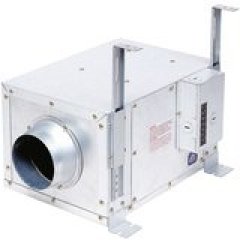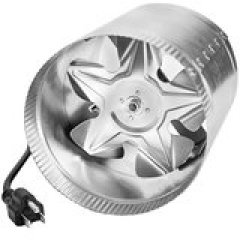
An extremely quiet blower that features sturdy construction.
An extremely quiet blower that features sturdy construction.
Ventilate several areas with one inline vent fan. Quiet suction blower. Adjustable airflow. Designed to last. Energy Star rated.
Was not made with a power cord; this model should be installed by a professional.

This cheap, yet effective inline vent fan is the perfect solution for DIY enthusiasts on a budget.
This cheap, yet effective inline vent fan is the perfect solution for DIY enthusiasts on a budget.
Extremely affordable. The included power cord makes it easy to install. This is a long-lasting fan with overall durable construction. Requires no maintenance. Lightweight.
Not intended for use in areas with temperatures over 130 degrees, or in high-humidity spaces.

A comprehensive cooling solution for AV equipment rooms, closets, or for providing air circulation to small areas.
A comprehensive cooling solution for AV equipment rooms, closets, or for providing air circulation to small areas.
Includes a programmable temperature controller. Simple plug-and-play design. Quiet PWM motor. Energy-efficient.
Although the temperature controller is easy to operate, it doesn’t have a feature for monitoring or managing humidity.

This inline vent fan will run 50% quieter than its competition.
This inline vent fan will run 50% quieter than its competition.
Affordable. Easy-to-install with its four-foot power cord. Durable all-metal construction. Lightweight. Designed for minimum noise. Portable. A straightforward option for anyone who needs to ventilate an attic, basement, or bathroom.
While this is an inexpensive inline vent fan, it is definitely noisier than a premium model would be.

This adaptable inline duct fan offers easy installation, compact design, adjustable fan speeds, and subdued noise levels.
This adaptable inline duct fan offers easy installation, compact design, adjustable fan speeds, and subdued noise levels.
Powerful air flow. Durable construction resists extreme heat and humidity. Includes a 5.4 foot-long power cable. Speed controller adjusts for 3 blowing speeds. The mounting bracket can be attached to walls, ceilings, or floors.
Note that it’s a low-noise inline vent fan, not a silent one, and VIVOSUN offers a matching silencer to reduce noise further.

We recommend these products based on an intensive research process that's designed to cut through the noise and find the top products in this space. Guided by experts, we spend hours looking into the factors that matter, to bring you these selections.

Inline vent fans are so versatile and varied that they’re used everywhere from bathrooms to grain barns. They’re used to exhaust airborne contaminants and improve working conditions. They’re widely used in grow rooms to circulate air and help maintain a balanced environment for plants. They can be a popular solution to some HVAC problems. And specialized industrial versions are designed to remove excess moisture from kilns and furnaces.
Inline vent fans, duct fans, booster fans, axial fans, belt-drive fans…the variety of different names for very similar devices can make it a real challenge to know what you need, and that’s before you even start looking at the specifications.
Here at BestReviews, it’s our job to unravel all these complications and provide the advice you need to make the right buying decision. While there are too many potential applications for inline vent fans for us to cover every use case, we can cover the most popular types, show you which elements demand the most attention and recommend some of our favorites.

Probably the single most important aspect of an inline vent fan is the airflow generated, which is given in cubic feet per minute (CFM). Depending on the installation, you might need to move a set amount of air continuously or completely replace the volume of a room in a given time period, once an hour, for example.
Some calculations are straightforward. If you have a 144-square-foot room with a ceiling height of 8 feet, that’s 1,152 cubic feet. Experts recommend adding a 30% margin, making a total of 1,497.6. So if you want to change the air once a minute (admittedly pretty extreme), you’d need a 1,500 CFM fan. If you wanted to change it six times an hour, you’d need a 150 CFM fan.
Each situation is different. For instance, if you add air filtration, you’ll probably have to increase the airflow to compensate for the restriction the filter can cause. You’ll either need to research your specific situation (there is a lot of valuable advice online about setting up grow rooms, for example) or consult a specialist. It’s vital that you take your time over this aspect. If the cubic feet per minute are wrong, the fan won’t provide the results you need.
Physical size is important both in terms of the space where you have to fit it and the diameter of ductwork it’s connected to. Most inline vent fans are specified by this diameter. The smallest are generally 4 inches, and it’s unusual to see them larger than 12 inches.
External dimensions are equally important. Household models and most grow room fans have motors that are mounted within the unit and so remain relatively compact. Industrial vent fans might have a belt drive from a motor mounted on the outer casing.
Many inline vent fans require minimal control. They are either always on, activated by some kind of manual on/off switch, or start and stop automatically, when linked to a heating, ventilating, and air conditioning (HVAC) system, for example.
Others offer further options, such as different speeds (up to ten) adjusted via a handheld or wall-mounted controller. Advanced inline vent fans have sensors and can be set to activate automatically at given temperatures or humidity. They can also have timers, as well as alarms if certain conditions are exceeded.
If you’re installing an inline vent fan yourself, remember to check the airflow direction. There should be an arrow on the casing.
Body: The materials the inline vent fan is made of may need to be considered, too. Most cheap models have a galvanized steel body to prevent rust, but they aren’t really designed to be used in damp environments. For that kind of application, a ceramic coating provides better protection, and a sealed motor is often offered. There are also models designed for use where extreme heat might be a problem, or where there’s the potential for a fire hazard.
Blades: Another feature of low-cost fans is a plastic impeller (fan blade), whereas metal gives improved durability.
You also want to think about how the fan will be mounted. Brackets of some kind are usually built in, but they may need to be adapted. Although some fans are light, it’s not a good idea to fit them into flexible ducting without some form of support.
Noise is an issue in some cases. It can be given as either decibels or sones. A sone is quieter than a whisper. Four sones don’t seem like a big number, but that’s an inline vent fan that’s as loud as a motorcycle! On the other hand, quality models can be so quiet you won’t normally hear them.
The power requirement in the majority of cases is the standard 110/120 volts. Many simply plug into a standard household outlet (you should probably check the cord length). Others, particularly those with high-end control functions, require special wiring. When you’re thinking about costs, you might need to consider the services of an electrician.
Maintenance is seldom necessary in household situations, but regular cleaning is frequently needed where there are airborne contaminants like grease from commercial kitchens or dust from industrial processes. In these cases, it’s a good idea to look for models with sealed bearings, which prevents them from excessive wear (they’re usually quieter, too). Seals might also be used to prevent dust or liquid ingress, providing further protection for your fan.
If the fan motor is fitted with an older-style brush motor, then eventually the brushes will need to be replaced (though it could be several years). Modern brushless motors are maintenance-free, but they do add to the cost.
Most inline vent fans are axial — they push or pull air along the same direction as the ducting. Occasionally, there’s a need to redirect that air at right angles (usually industrial cooling or commercial HVAC applications). In those cases, a centrifugal fan is required. Rather than the ordinary fan blades, it has what looks like a paddle wheel to direct airflow.

Inexpensive: The cheapest inline vent fans start at around $25 for a 4-inch booster model. There are two main criticisms aimed at these low-cost devices: performance doesn’t match the claimed cubic feet per minute, and durability can be a bit hit or miss.
Mid-range: There’s a huge amount of choice between $35 and $100, with inline vent fans for just about every purpose, including a few of the smaller grow room fans with modest feature sets.
Expensive: Large inline vent fans (8 inches and larger) and those with complex control functions can cost anywhere from $100 to $300, as can some that provide extraction from multiple rooms. Many industrial duct fans also fall within this bracket, though high-throughput models for wet environments can be $1,000 or more.
Components that are UL listed have been tested by a Nationally Recognized Testing Laboratory (NRTL) in accordance with safety standards approved by the US Occupational Safety and Health Administration (OSHA).
Sometimes parts of your home don’t seem to get the heating or cooling they need to make them comfortable, even when your HVAC is keeping the rest of the house just how you want it. The culprit is likely to be the ductwork. Long sections reduce airflow, and the situation is made worse if there are a number of turns the air has to negotiate.
An inline vent fan, or booster fan, can be added to a section of ductwork to increase the airflow and fix the problem. However, getting to your ductwork may not be easy, and the work involved might well require the services of a professional. Before you go down that road, there are a number of things worth checking. There will probably be parts of the system you can’t check visually but spending a while on a patient inspection of what you can see might save you hundreds of dollars.

A. Although installation can be a little more complicated, the fact that the fan is placed in the roof void rather than on the bathroom ceiling means it should be noticeably quieter. The other potential advantage is that you could run ducting from more than one room through the same inline fan. That way, you might actually save some time and money.
A. In these circumstances, we’d say the vent is the fan unit — the device that moves the air — whereas ducts are the tubing the air flows through. Having said that, inline vent fans and inline duct fans are basically the same thing, and the descriptions are interchangeable. You’ve also got exhaust fans, which are vent fans that provide extraction.
A. So much depends on the type of installation and the skills of the individual that it’s impossible for us to give a yes or no answer. Putting in a basic vent fan can be a straightforward job for someone with knowledge of household electrics, but altering your HVAC system requires specialist knowledge. We’d say that if you have to ask the question, you should probably call a pro.
Get emails you’ll love.
Learn about the products you’re wondering if you should buy and get advice on using your latest purchases.
